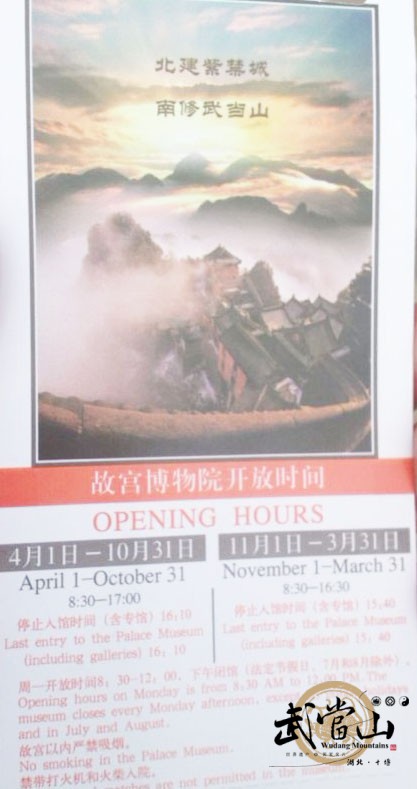Beijing’s Palace Museum promotes Wudang Mountains
( chinadaily.com.cn )
Updated: 2014-01-27
Tickets of the Palace Museum in Beijing’s Forbidden City recently started to feature an image of Wudang Mountains, in a bid to increase awareness of the site as a tourist destination among visitors from around the world, wudangshan.gov.cn reported.
In 2012, 15.34 million visitors enjoyed the exhibits at the Palace Museum, the highest number of visitors of all scenic spots in China. About 600 years ago, the Forbidden City was built in the north of the country and Wudang Mountains in the south, symbolizing peace and prosperity, and the two UNESCO World Heritage Sites are cooperating.
In recent years, Wudang Mountains Tourism and Economy Special Region has aimed to make innovations in marketing and concepts, focused on building its tourism brand, and expanding its market share. And, over the past decade, the number of tourists visiting Wudang Mountains has increased from 200,000 to 4.5 million in 2012.
The Forbidden City and Wudang Mountains have in fact cooperated in the past, for example when they jointly organized the 2010 Forbidden City-Wudang Mountains ( Ming Dynasty) culture seminar and the 2012 World Cultural Heritage Forum and China Forbidden City Institute annual conference.
Construction of the Forbidden City began in 1406 during the Ming Dynasty (1368-1644), and it was completed in 1420. It covers an area of 720,000 square meters and is China’s largest and most complete ancient architectural complex.
Construction of the Wudang Mountains site started in 1412 and lasted for 12 years, and its grand scale and majesty mean that it is sometimes referred to as the “Forbidden City Above the Cloud”.
 |
|
A ticket of the Palace Museum in Beijing's Forbidden City shows a picture of Wudang Mountains in Shiyan city, Hubei province. [Photo/wudangshan.gov.cn] |



